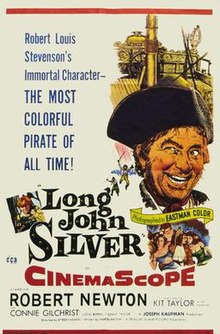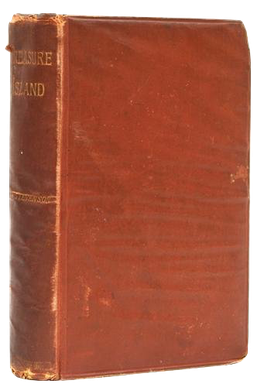
Treasure Island is an adventure novel by Scottish author Robert Louis Stevenson, telling a story of "buccaneers and buried gold". It is considered a coming-of-age story and is noted for its atmosphere, characters, and action.

Long John Silver is a fictional character and the main antagonist in the novel Treasure Island (1883) by Robert Louis Stevenson. The most colourful and complex character in the book, he continues to appear in popular culture. His missing leg and parrot, in particular, have greatly contributed to the image of the pirate in popular culture.

Robert Guy Newton was an English actor. Along with Errol Flynn, Newton was one of the more popular actors among the male juvenile audience of the 1940s and early 1950s, especially with British boys. Known for his hard-living life, he was cited as a role model by the actor Oliver Reed and the Who's drummer Keith Moon.

His Majesty O'Keefe is a 1954 American adventure film directed by Byron Haskin and starring Burt Lancaster. The cast also included Joan Rice, André Morell, Abraham Sofaer, Archie Savage, and Benson Fong. The screenplay by Borden Chase and James Hill was based on the novel of the same name by Laurence Klingman and Gerald Green (1952).
Ronald Grant Taylor was an English-Australian actor best known as the abrasive General Henderson in the Gerry Anderson science fiction series UFO and for his lead role in Forty Thousand Horsemen (1940).

The Legends of Treasure Island is a British animated television series. It had two series of 13 episodes each and each episode runs for 22–25 minutes.
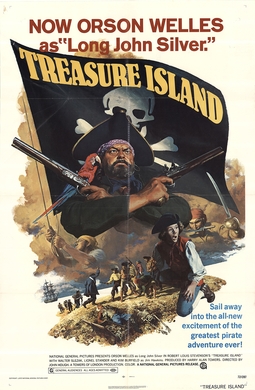
Treasure Island is a 1972 adventure film, based on the 1883 novel by Robert Louis Stevenson. The film stars Orson Welles as Long John Silver, Kim Burfield as Jim Hawkins, Walter Slezak as Squire Trelawney, Rik Battaglia as Captain Smollett, and Ángel del Pozo as Doctor Livesey.

Treasure Island is a 1934 film directed by Victor Fleming and starring Wallace Beery, Jackie Cooper, Lionel Barrymore, Lewis Stone, and Nigel Bruce. It is an adaptation of Robert Louis Stevenson's famous 1883 novel of the same name. Jim Hawkins discovers a treasure map and travels on a sailing ship to a remote island, but pirates led by Long John Silver threaten to take away the honest seafarers’ riches and lives.

Treasure Island is a 1950 adventure film produced by RKO-Walt Disney British Productions, adapted from Robert Louis Stevenson's 1883 novel of the same name. Directed by Byron Haskin, it stars Bobby Driscoll as Jim Hawkins and Robert Newton as Long John Silver. Treasure Island was Disney's first completely live-action film and the first screen version of Treasure Island made in color. It was filmed in the United Kingdom on location and at Denham Film Studios, Buckinghamshire.
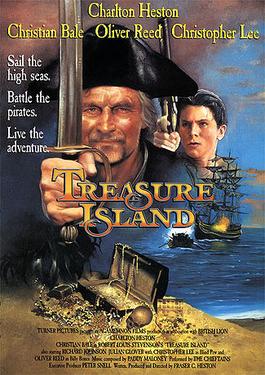
Treasure Island is a 1990 British-American made-for-television film adaptation of Robert Louis Stevenson’s 1883 novel of the same name, written and directed by Fraser Clarke Heston, and also starring several notable British actors, including Christian Bale, Oliver Reed, Christopher Lee, Julian Glover and Pete Postlethwaite.

The Adventures of Long John Silver is a TV series about the Long John Silver character from Robert Louis Stevenson's 1883 novel Treasure Island. It was made in 1954 in colour in Australia for the American and British markets before the development of Australian television.

Treasure Island is a 1920 silent film adaptation of the 1883 novel by Robert Louis Stevenson, directed by Maurice Tourneur, and released by Paramount Pictures. Lon Chaney played two different pirate roles in this production, "Blind Pew" and "Merry", and stills exist showing him in both makeups. Charles Ogle, who had played Frankenstein's Monster in the first filmed version of Frankenstein a decade earlier at Edison Studios, portrayed Long John Silver. Wallace Beery was supposed to play Israel Hands, but that role went to Joseph Singleton instead. The film was chosen as one of the Top Forty Pictures of the Year by the National Board of Review.
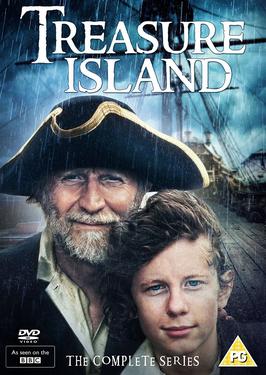
Treasure Island is a 1977 television adaptation of Robert Louis Stevenson's famous 1883 novel. It was filmed in 1977 on location in Plymouth and Dartmouth (Devon), and in Corsica, and also at BBC Television Centre at Wood Lane, London.

Pirates of Treasure Island is a 2006 American comedy-drama film produced by The Asylum, loosely adapted from Robert Louis Stevenson's 1883 novel Treasure Island.
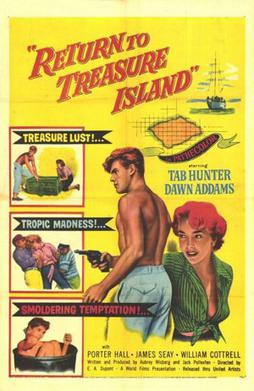
Return to Treasure Island is a 1954 American adventure film directed by Ewald André Dupont and starring Tab Hunter, Dawn Addams and Porter Hall. Shot in Pathécolor it was distributed by United Artists. The film is about modern-day adventurers exploring the desert island from Robert Louis Stevenson's frequently filmed 1883 novel Treasure Island. Though Stevenson's story was fictional, it is treated as historical for the purposes of the film's plot.

Lovers and Luggers is a 1937 Australian film directed by Ken G. Hall. It is an adventure melodrama about a pianist who goes to Thursday Island to retrieve a valuable pearl.
Lloyd Berrell was a New Zealand actor who played Reuben "Roo" Webber in the original Sydney production of Summer of the Seventeenth Doll. He worked extensively in Australian radio and theatre, appearing in a large portion of the films being shot locally at that time. He also starred in the original stage production of Sumner Locke Elliott's Rusty Bugles as well as numerous productions for the Mercury Theatre.
Pagewood Studios was a film studio in Sydney, Australia, that was used to make Australian, British and Hollywood films for 20 years.

Treasure Island is a 1918 American silent adventure film based on the 1883 novel of the same name by Robert Louis Stevenson. This is one of many silent versions of the story and is noteworthy because it is almost entirely acted by child or teenage actors. The film was co-directed by brothers Sidney and Chester Franklin. The film is one of Fox's Sunset Kiddies productions following in the wake of previous Kiddie productions like Aladdin and his Wonderful Lamp. This is a lost film.
Treasure Island, original title Die Schatzinsel, is a German-French mini-series, produced for German television station ZDF in 1966. The screenplay by Walter Ulbrich, who also co-produced the film, remains largely close to Robert Louis Stevenson's classic 1883 novel Treasure Island.
